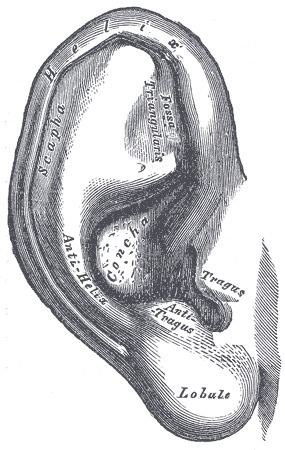TA A15.3.01.003 | Dorlands/Elsevier l_13/12500813 FMA 60984 | |
 | ||
Latin lobulus auriculae (singular), lobuli auricularum (plural) | ||
The human earlobe (lobulus auriculae) is composed of tough areolar and adipose connective tissues, lacking the firmness and elasticity of the rest of the auricle (the external structure of the ear). In some cases the lower lobe is connected to the side of the face. Since the earlobe does not contain cartilage it has a large blood supply and may help to warm the ears and maintain balance. The zoologist Desmond Morris in his book The Naked Ape (1967) conjectured that the lobes developed as an additional erogenous zone to facilitate the extended sexuality necessary in the evolution of human monogamous pair bonding. However, earlobes are not generally considered to have any major biological function. The earlobe contains many nerve endings, and for some people is an erogenous zone.
Contents
Earlobe's organogenesis
It might seem to be that the earlobe, as a body part built of epithelium and connective tissue, is derived from dermatome. However this is not the case, in the surrounding tissue there are no somites – thus also there is no dermatome. In this area, the dermis is derived from cells of mesenchymal cells, whereas the mesenchyme is derived from the sclerotome and splanchnopleura located in the nearby regions of the torso.
The earlobe as a body part arises and develops in the vicinity of of auricular follicle, as a result of cascade induction:
- The first-level inductor is the central segment of Archenteron's roof, which induces the production of the Medulla oblongata (part of the Hindbrain).
- The second-level inductor is the Medulla oblongata, which induces the production of a pair of auricular follicles derived from the mesoderm.
- The third-level inductor is the auricular follicle, which induces the production of the auditory bulla.
Genetics
Earlobes average about 2 centimeters long, and elongate slightly with age. Although the "free" vs. "attached" appearance of earlobes is often presented as an example of a simple "one gene - two alleles" Mendelian trait in humans, earlobes do not all fall neatly into either category; there is a continuous range from one extreme to the other, suggesting the influence of several genes.
Clinical significance
Earlobes are normally smooth, but occasionally exhibit creases. Creased earlobes are sometimes associated with genetic disorders in children, including Beckwith-Wiedemann syndrome. In some early studies, earlobe creases were thought to be associated with an increased risk of heart attack and coronary heart disease; however, more recent studies have concluded that since earlobes become more creased with age, and older people are more likely to experience heart disease than younger people, age may account for the findings linking heart attack to earlobe creases. The earlobe crease is also called Frank's Sign.
Earlobe piercing and stretching
Piercing the earlobes is a commonplace activity in many cultures in many historical eras; no other location on the body is as commonly pierced. Consequently, injury to the earlobe due to the weight of heavy earrings is also common. Some cultures practice earlobe stretching, using piercing ornaments to stretch and enlarge the earlobes to accommodate plugs.
Negative effects of wearing earrings
Some research has found that the most frequent complications connected with wearing earrings are:
There was noticeable relationship between the piercing of young girls' earlobes and following development of allergy. In the view of Professor Ewa Czarnobilska, the manager of the research team, the primary reason for the allergies connected to earrings is the presence of nickel, which is a common component of the alloys used in jewelry production. The symptom seen is generally eczema, and is often misdiagnosed as a food allergy, for instance to milk. The specific mechanism in allergies caused by earrings is the contact of nickel ions with the Lymphatic system.
The study noted that children who simply stopped wearing earrings did not see the disappearance of the allergic symptoms. The immune system remembers the presence of the nickel ions in the person's blood and lymph, so the child can still react to:
Research by allergists has found that in a sample of 428 pupils of ages 7–8 and 16–17 years old:
Other symptoms of allergy to nickel are recurring infections, Asthma attacks and chronic larynxis.
